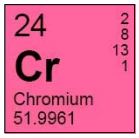Chromium
View/Download PDF Version
Chromium
- Chromium is a grayish-white metallic element commonly occurring in nature. Chromium is used in electroplating, alloy metals, and as a corrosion inhibitor in the textile, glass, and photographic industries. Potential sources of contamination in drinking water include discharge from steel and pulp mills and erosion of natural deposits.
- The US Environmental Protection Agency (USEPA) has set a drinking water standard of 0.1 mg/L for chromium in public drinking water supplies. These regulations do not apply to private water supplies but the health implications are the same for private well owners.
- Short term (i.e. 1 day) exposure to drinking water with a chromium concentration at more than 10 times the USEPA standard is not thought to be dangerous. However, the more likely health effect from chromium comes from low dosages over a long period of time or “chronic” effects. Allergic inflammation of the skin is the primary health effect from chromium.
- Treatment of water for chromium can be accomplished with ion exchange, reverse osmosis, or distillation systems.
Additional Resources
Click on the links below to be directed to more resources.
US EPA National Primary Drinking Water Regulations
Water Quality Interpretation Tool
Handbook of Drinking Water Quality; John DeZuane; 1997
